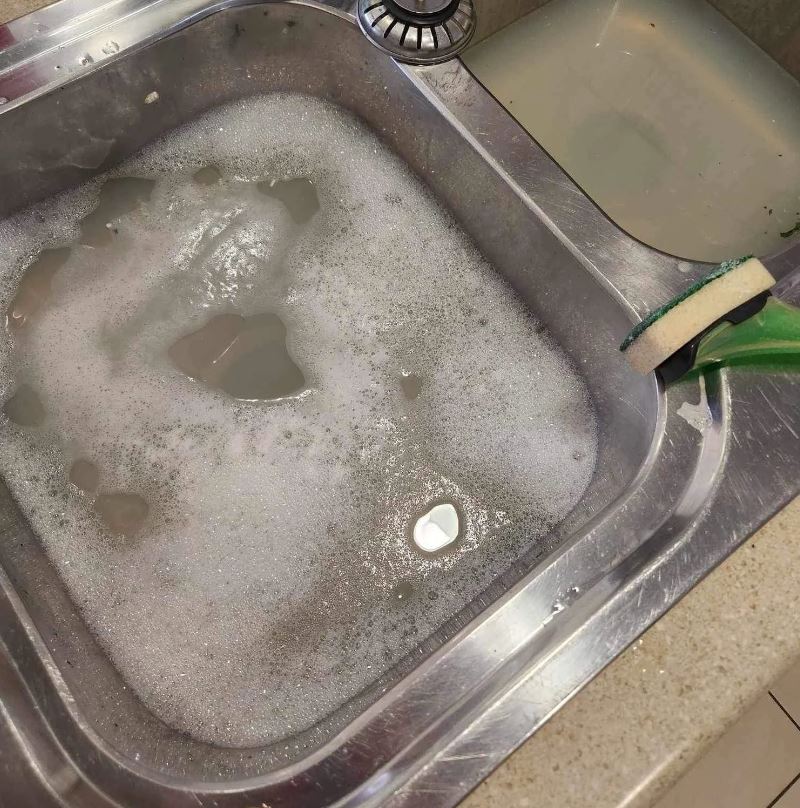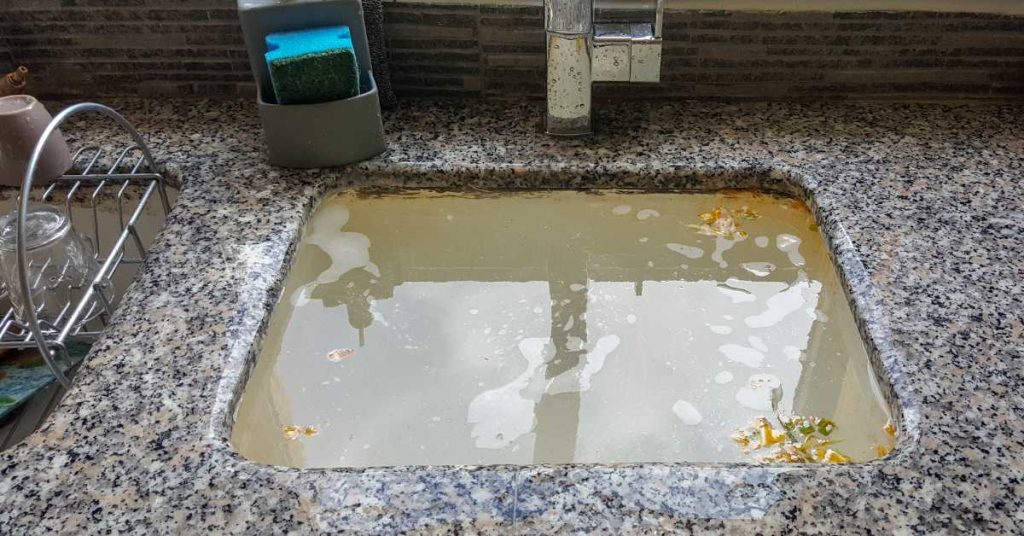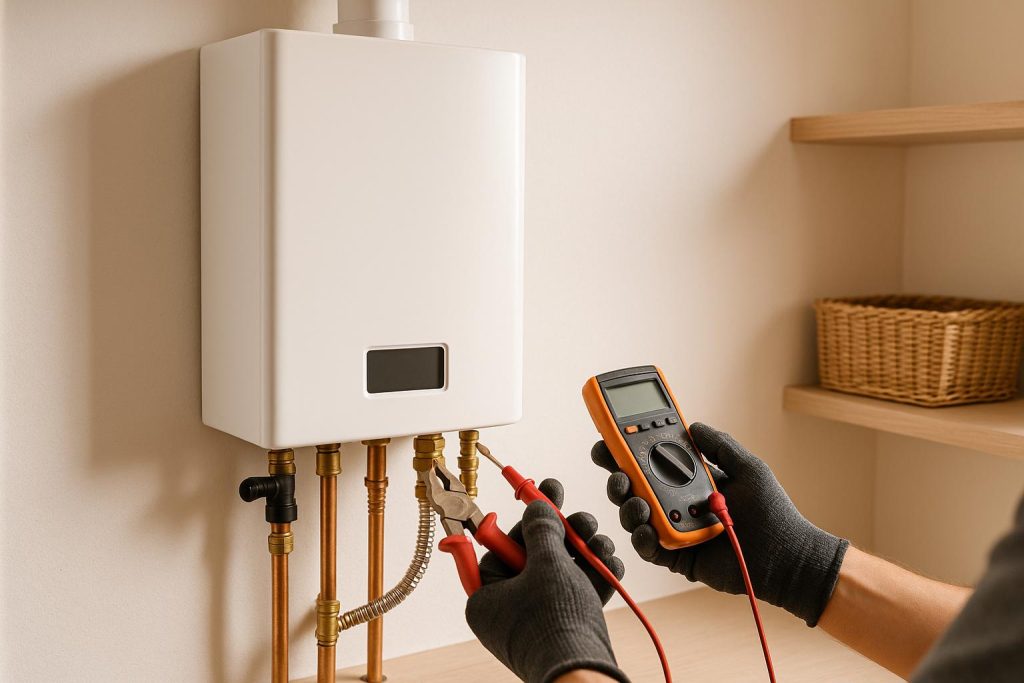Tired of dealing with slow drains and messy backups? The good news is that preventing kitchen sink clogs doesn’t require fancy tools or harsh chemicals, just a few simple habits. From catching grease before it cools to flushing with hot water, these tips help keep your pipes clear and your cleanup stress-free.
Follow this guide and say goodbye to frustrating blockages, ensuring your drain stays clear and your cleanup stays stress‑free.
Why Your Kitchen Sink Gets Clogged

Kitchen sinks get clogged for a handful of everyday reasons:
- Grease and oil buildup: Leftover cooking fats solidify inside your pipes when they cool.
- Food scraps: Bits of potato peel, pasta, or vegetables can slip past the disposal or strainer and settle in the drain.
- Non‑flushable items: Paper towels, wipes, or small utensils sometimes find their way into the drain.
- Hard water deposits: Minerals like calcium and magnesium can coat the inside of your pipes, trapping other debris.
Understanding these causes makes it much easier to adopt the right preventative habits.
Proven Tips to Prevent Kitchen Sink Clogs
1. Dispose of Grease and Oils Properly
Hot cooking oils look harmless as they swirl down your drain, but once they cool, they solidify and cling to pipe walls, trapping food bits over time. To prevent kitchen sink clogs, capture grease in a heat‑safe container and toss it in the trash after it solidifies. It’s a tiny habit with a big payoff: fewer blockages and less risk of a messy plumbing emergency.
- Pour cooled grease into a jar or can.
- Let it solidify before discarding.
- Never rinse hot oils down the drain.
- Label your grease container for household use.

2. Use a Sink Strainer Every Time
Even the tiniest potato peels, coffee grounds, and fruit seeds can slip past your sight and lodge in the U‑bend under your sink. A simple mesh strainer lets you prevent kitchen sink clogs by catching particles before they enter. Empty it into the trash after each meal prep, no fancy tools are needed.
- Choose a fine‑mesh stainless steel strainer.
- Empty debris into the trash, not the sink.
- Rinse the strainer under running water.
- Replace it if it shows wear or rust.

3. Run Hot Water After Each Use
Even when you wipe dishes clean, tiny traces of grease and soap scum cling to pipe walls. A quick 30–to 60-second blast of hot water helps prevent kitchen sink clogs by flushing away residues, melting lurking fats, and pushing loose debris further down the line. Do this after every dishwashing session to give your drain a regular “self‑clean.”
- Turn the hot tap on full blast.
- Keep it running for at least 30 seconds.
- Use water that’s as hot as your plumbing safely allows.
- Combine with a mild detergent rinse.

4. Clean Your Drain Monthly with Vinegar and Baking Soda
Soap scum, mineral deposits, and tiny food particles build up over weeks without you noticing. Once a month, pour ½ cup of baking soda down the drain, follow with ½ cup of white vinegar, and let the fizzy reaction work for 5–10 minutes. Then flush with hot water to flush out grime and help prevent kitchen sink clogs naturally; no harsh chemicals are required.
- Measure equal parts baking soda and vinegar.
- Let it fizz undisturbed for 10 minutes.
- Always finish with a hot water flush.
- Use this natural method instead of harsh chemicals.

5. Avoid Overfeeding the Garbage Disposal
Garbage disposals save time, but they aren’t miracle machines. Fibrous veggies like celery, coffee grounds, eggshells, and starchy pasta can foul the blades or paste together into stubborn blockages. To prevent kitchen sink clogs, feed scraps slowly with plenty of cold water, and when in doubt, toss tough bits into the trash.
- Only grind small, soft scraps at a time.
- Keep the cold water running throughout.
- Never overload in one go.
- Skip fibrous and starchy foods entirely.

6. Be Mindful of What Goes Down the Drain
Beyond food, everyday items like paper towels, wipes, dental floss, and plastic wrappers don’t break down and can tangle into instant clogs. Make it a firm household rule: if it isn’t water, soap, or tiny food bits, it belongs in the trash. This simple boundary helps you prevent kitchen sink clogs caused by non‑food debris.
- Educate everyone in your home.
- Keep a small trash bin by the sink.
- Post a “What not to flush” sign.
- Check disposal instructions for your model.

7. Scrape Plates Before Rinsing
Even with a disposal running and a quick rinse, chunks of food can still slip through and accumulate down the line. Use a rubber spatula or brush to scrape plates, bowls, and pans into the trash before they hit the sink. This extra step is key to preventing kitchen sink clogs from solid buildup.
- Keep a spatula by the sink.
- Scrape all dishes over a waste bin.
- Rinse only after the solids are removed.
- Wipe bowls with a paper towel first if needed.

8. Install a Grease Trap (Optional Upgrade)
If you cook often with oils and fats, a small under‑sink grease trap can catch residual liquids before they enter your drain line. It’s a one‑time installation by a plumber that can save you recurring headaches and professional cleaning fees down the road.
- Consult a licensed plumber.
- Choose an EPA‑approved grease trap.
- Empty the trap per the manufacturer’s instructions.
- Inspect for leaks during regular checks.

9. Schedule Regular Plumbing Check‑Ups
Early mineral deposits, slight misalignments, or tiny leaks often go unnoticed until they become major blockages or costly repairs. By having a licensed plumber inspect and clean your drains once a year (using camera scopes or hydro‑jetting), you’ll catch problems early and prevent kitchen sink clogs from sneaking up later.
- Book an annual inspection.
- Ask about camera pipe scopes.
- Consider hydro‑jet cleaning.
- Keep records of service dates.
How to Fix a Clogged Sink (DIY & When to Call a Pro)
Even the best preventative routine can’t guarantee zero clogs, accidents happen! Here’s how to tackle stubborn blockages:
- DIY First Aid
- Plunger: Create a firm seal over the drain and plunge vigorously. That back‑and‑forth pressure often breaks up small obstructions.
- Homemade Cleaner: Baking soda + vinegar fizz can dislodge gunk. Pour ½ cup baking soda, then ½ cup vinegar down the drain. After fizzling for 10 minutes, flush with hot water.
- Plunger: Create a firm seal over the drain and plunge vigorously. That back‑and‑forth pressure often breaks up small obstructions.
- When to Call a Plumber
- Persistent Backup: If the sink still drains slowly after DIY efforts, there’s likely a deeper issue.
- Multiple Fixture Backup: Water backing up into your dishwasher or another sink indicates a main line blockage.
- Gurgling or Foul Odors: Strange sounds or sewage smells suggest trapped debris far down the pipe.
- Persistent Backup: If the sink still drains slowly after DIY efforts, there’s likely a deeper issue.
When to Call a Professional Plumber for Help
Letting a blockage sit can damage your pipes and lead to leaks or broken seals. If you notice any of these red flags, schedule a service call right away:
- Water pooling despite plunging and homemade cleaners
- Gurgling noises from adjacent fixtures
- Sewage or rotten egg odors from your drain
- Visible leaks or damp spots under the sink
A licensed plumber can perform camera inspections, use high‑pressure water jetting, or replace damaged pipe sections getting to the root of the problem safely and quickly.
Final Thoughts
Keeping your sink clear is really simple. Just use a strainer to catch food scraps, never pour grease down the drain, and run hot water through your pipes once in a while. These small steps will help you avoid clogs and make cleanup much easier. If you do get a clog, try a homemade cleaner or a quick plunge. If that doesn’t work, don’t hesitate to call a professional. Follow these tips, and you’ll spend less time worrying about backups and more time enjoying your kitchen. And if clogs keep coming back, Plumbing Sniper is ready to help; just give them a call!






